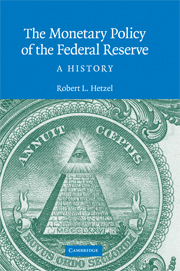Book contents
- Frontmatter
- Contents
- Figures
- Preface
- 1 The Pragmatic Evolution of the Monetary Standard
- 2 Learning and Policy Ambiguity
- 3 From Gold to Fiat Money
- 4 From World War II to the Accord
- 5 Martin and Lean-against-the-Wind
- 6 Inflation Is a Nonmonetary Phenomenon
- 7 The Start of the Great Inflation
- 8 Arthur Burns and Richard Nixon
- 9 Bretton Woods
- 10 Policy in the Ford Administration
- 11 Carter, Burns, and Miller
- 12 The Political Economy of Inflation
- 13 The Volcker Disinflation
- 14 Monetary Policy after the Disinflation
- 15 Greenspan's Move to Price Stability
- 16 International Bailouts and Moral Hazard
- 17 Monetary Policy Becomes Expansionary
- 18 Departing from the Standard Procedures
- 19 Boom and Bust: 1997 to 2001
- 20 Backing Off from Price Stability
- 21 The Volcker–Greenspan Regime
- 22 The Fed: Inflation Fighter or Inflation Creator?
- 23 The Stop–Go Laboratory
- 24 Stop–Go and Interest Rate Inertia
- 25 Monetary Nonneutrality in the Stop–Go Era
- 26 A Century of Monetary Experiments
- Appendix: Data Seen by FOMC for the Stop–Go Period Shown in Figures 24.1, 24.2, and 24.3
- Notes
- Bibliography
- Index
- Titles in the series
25 - Monetary Nonneutrality in the Stop–Go Era
Published online by Cambridge University Press: 26 May 2010
- Frontmatter
- Contents
- Figures
- Preface
- 1 The Pragmatic Evolution of the Monetary Standard
- 2 Learning and Policy Ambiguity
- 3 From Gold to Fiat Money
- 4 From World War II to the Accord
- 5 Martin and Lean-against-the-Wind
- 6 Inflation Is a Nonmonetary Phenomenon
- 7 The Start of the Great Inflation
- 8 Arthur Burns and Richard Nixon
- 9 Bretton Woods
- 10 Policy in the Ford Administration
- 11 Carter, Burns, and Miller
- 12 The Political Economy of Inflation
- 13 The Volcker Disinflation
- 14 Monetary Policy after the Disinflation
- 15 Greenspan's Move to Price Stability
- 16 International Bailouts and Moral Hazard
- 17 Monetary Policy Becomes Expansionary
- 18 Departing from the Standard Procedures
- 19 Boom and Bust: 1997 to 2001
- 20 Backing Off from Price Stability
- 21 The Volcker–Greenspan Regime
- 22 The Fed: Inflation Fighter or Inflation Creator?
- 23 The Stop–Go Laboratory
- 24 Stop–Go and Interest Rate Inertia
- 25 Monetary Nonneutrality in the Stop–Go Era
- 26 A Century of Monetary Experiments
- Appendix: Data Seen by FOMC for the Stop–Go Period Shown in Figures 24.1, 24.2, and 24.3
- Notes
- Bibliography
- Index
- Titles in the series
Summary
The overview of stop–go in Chapters 23 and 24 identified monetary shocks with the monetary accelerations and decelerations associated with cyclical interest rate smoothing. Chapter 24 examined the timing relationships between these shocks and macroeconomic variables. This chapter uses a narrative overview to trace out the relationship between monetary disturbances, the real interest rate, and real output (hours worked).
A Narrative Overview
Starting in late 1968, the FOMC decided to lower inflation, which had risen from just over 1% in the years from 1960 through 1965 to 5% in the last half of 1968. It raised the funds rate and kept it at a cyclically high level even when weakness appeared in nominal output growth. M1 growth peaked in January 1969, growth in hours worked peaked six months later in July 1969, and the real rate peaked even later in July 1970 (row 3, Table 25.1). An empirical regularity is the lag in turning points in the real rate behind hours worked. In Table 25.1, column 7 shows the lag in turning points of hours worked behind M1, and column 8 shows the lag in turning points of the real rate behind hours worked.
In March 1971, the FOMC pushed the funds rate down to 3.5% (Figure 8.2). From February through June 1971, the real commercial paper rate averaged only .3% (Figure 8.3). M1 growth surged into low double-digits (Figure 8.2). Over the longer period from November 1965 through January 1971, the real interest rate had averaged 2.9%.
- Type
- Chapter
- Information
- The Monetary Policy of the Federal ReserveA History, pp. 303 - 310Publisher: Cambridge University PressPrint publication year: 2008

